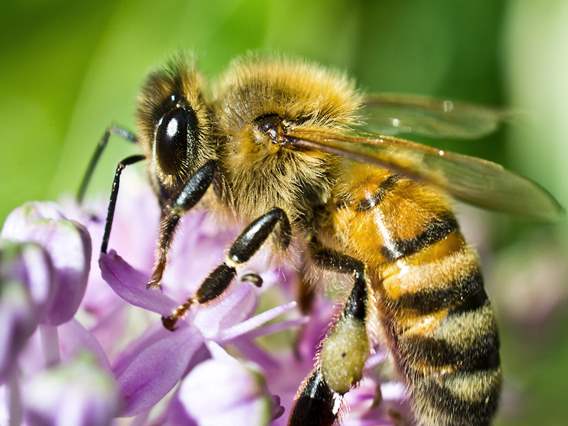How to Treat a Bee Sting

Remember to get help from an adult!
In the summer when you are outside playing and enjoying some fun in the sun, you might hear something buzzing nearby. Most likely, you are hearing the sound of a bee moving between its colony and flowers where it has collected pollen. You may rush up to chase the bee or get a closer look when OUCH! You got stung by a bee!
Sometimes, we accidentally disturb bees or get too close to their hives and they sting us as a result. But don’t worry! In most situations, the pain will be brief and then gone for good. You just have to make sure you remove the stinger and treat it well.
If you are stung, find a parent, teacher or other grownup and tell them right away, as they will know what to do for a bee sting. The treatment is quick and easy, and soon you'll be feeling better.

Step One for How to Treat a Bee Sting: Clean It Out
The first thing an adult will do to treat your sting is clean and clear it out, making sure the stinger is removed. This part is very important because a bee’s stinger delivers venom.
Did you know a honeybee’s stinger is barbed and will often get stuck in the person or animal it stings? The good news is since the bee lost its stinger, it can't sting you again. The bad news is until the stinger is removed, more venom might get into your bee sting. On the other hand, other stinging insects like wasps have smoother stingers and are able to sting more than once!
Now, back to that bee sting... With a pair of tweezers, the grownup will gently remove the stinger and wash the sting with soap and water to clean the area of germs. Removing the stinger may look or sound scary, but it is quite easy and basically painless…or at least it will hurt more if it stays in place!
If tweezers are not available, an adult can use a firm object like a credit card to sweep across the site and pull out the stinger.
However, don't squeeze or pinch the skin to remove the stinger, as this will cause additional venom to be released into the bite
Step Two for How to Treat a Bee Sting
Getting a bee sting isn’t a fun experience because it can be painful and maybe even a little frightening but usually it is a quick, brief time of pain. Some people, however, can be allergic to bee stings and will have a bad reaction when stung requiring additional medical treatment.
For those who experience a bee sting, most cases will be mild. Common symptoms include pain at the sting site, reddening and swelling of the sting, along with irritation and itchiness. In other cases, people can be allergic to bee stings resulting in a more severe reaction.
If you, a family member or a friend are stung by a bee and feel very sick after or know you have an allergy, it is important to see a doctor immediately so they can help. Most people who have bee sting allergies will carry a medical item called an EpiPen, which they can use with a grownup’s help to fight a bad reaction to a bee sting.

Step Three for How to Treat a Bee Sting
The next thing an adult will do is soothe your bee sting. With the stinger removed, the best way to do that is with some soothing ointment and/or antibiotic cream. Applying a cold compress or even a paper towel with cold water will help as well. An adult can consider giving you a pain reliever as needed. After a few hours, the pain should go away and you can get back to having fun!
Bees play a super important part in our environment and are known as pollinators, helping to fertilize plants and flowers. There’s no need to be scared of the sound of buzzing or the sight of bees; however, it is a good idea to give them plenty of space to prevent getting stung by a bee.
Remember, you are way bigger than a bee and they can be scared of you. So, avoid swatting at them as that may cause them to feel threatened and become more likely to sting you. Bees will want to get close to your snacks or even land on you if you are wearing colors that attract them or if you smell good. If they do, stay still and remain calm and the bee will fly off on its own.
Don’t let fear of a bee sting stop your fun. If it does happen, you can follow these simple steps for what to do for a bee sting, and before you know it, you’ll be playing again with the momentary sting as a distant memory.
Sting reaction symptoms and treatment information provided by Dr. Parada, Medical Advisor for NPMA. Always consult a medical professional.

